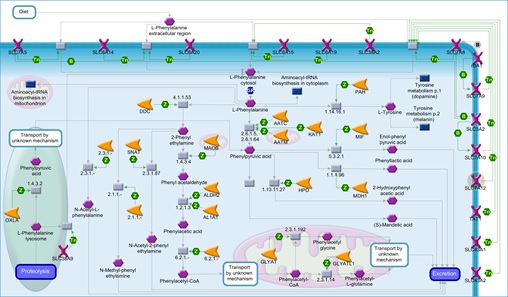The project financed by PO FESR SICILIA 2014-2020 (Action 1.1.5.) aims at the realization of a portable Point-of-Care (PoC) demonstrator, for the monitoring of phenylalanine (Phe) levels in patients suffering from hyperphenylalaninemia and at the demonstration of its functionality, robustness and reliability in a real operating environment. In the project, the research group of the IRIB in Catania is engaged in the characterization of the genomic alterations of the genes involved in the metabolism of Phe through the use of next-generation sequencing and DNA-microarray.
Phenylalanine (Phe) is an essential amino acid whose metabolism mainly passes (see figure) through the conversion into tyrosine by the hepatic enzyme phenylalanine hydroxylase (PAH), tetrahydrobiopterin (BH4) dependent, encoded by the PAH gene. People with PAH mutations or those encoding enzymes involved in the synthesis or regeneration of BH4 are unable to metabolize Phe correctly, which therefore accumulates in the blood and urine, causing severe damage to the central nervous system with consequent mental retardation, irreversible, medium-severe.
Hyperphenylalaninemia (HPA) shows the highest incidence rate among rare metabolic diseases (in Italy is 1: 3048 live births). Patients affected by HPA must constantly monitor plasma concentrations of Phe in order to modulate the diet/drug therapy to avoid incurring the neurotoxic damage mentioned above. The frequency of controls is strictly linked to age, to particular physiological conditions or to the ability to respond to the diet/drug therapy (genotype / phenotype correlation). To date, the techniques for monitoring the Phe concentration include the collection of blood on dried-blood-spots, the sending of the sample to the laboratory of the specialized reference center, the analysis using official analytical techniques, the processing and sending the result to the patient.
This approach does not allow real-time monitoring of therapy because from sampling to the final response from the laboratory the patient must wait at least 4-5 days. In this context, a portable and easy-to-use Point of Care (PoC) system would allow the patient’s quality of life to be improved by allowing direct self-monitoring of Phe values without the need to go to specialized laboratories.
CNR STAFF
- Sebastiano Cavallaro Research Director
- Maria Guarnaccia Technologist
- Giovanna Morello Research Fellow
- Elisabetta Tendi Research Fellow
Coordinators: 
Partnership: 



With: 



Dr Sebastiano Cavallaro
Research Director





